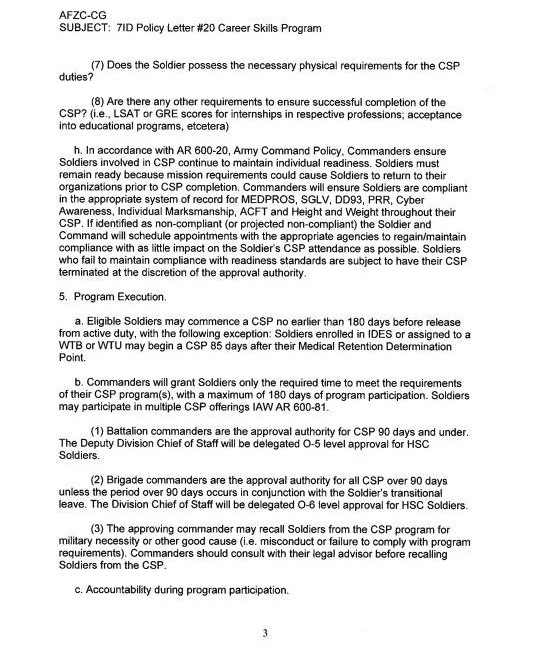The 7th Infantry Division just released a policy letter which clamps down on who can utilize the Army’s Career Skill Program. The program’s website states that CSP “affords transitioning Service Members the opportunity to participate in employment skills training (EST), on-the-job training (OJT), pre-apprenticeships and internships with a high probability of employment in high-demand and highly-skills jobs.” According to the policy letter, “commanders at the appropriate echelon will prioritize at risk populations for the program” then proceeds to outline who falls under this category.

The policy letter states, “the CSP prioritizes at-risk populations” and defines those at risk populations as soldiers 18-24 years old, those on their first enlistment, those being involuntary separated due to force shaping, and those being rapidly separated from active duty.



While CSP is a program that has always maintained the clause that it’s not guaranteed and is at the commander’s discretion as to who can participate, the emphasis on prioritizing those who have given the least amount of service to the Army vs. those who have been in longer, or may be retiring after serving for twenty years or more, feels like a slap in the face. Many soldiers rely on the program to help them transition out of service and into civilian life. It’s understood that not all personnel will be able to take part based on the demands of the unit and the potential to back fill that individual when they leave, but saying those who are 18-24 years old and/or on their first enlistment are an “at risk population,” while giving them preference, has already angered a number of soldiers who’ve written in to me.
Those who are still early in their career are watching. They’re watching the conversations regarding the reduction/removal of veteran’s benefits taking place in Congress and on the periphery, they’ve watched the incentive to serve for twenty years already disappear, and they’re watching as programs such as CSP, which was instituted at a time when the Army was trying to show good faith to its soldiers to ensure they had an easier time transitioning, are slowly picked away at. These observations will reflect in retention numbers.
LTG(R) Raymond Mason, Army Emergency Relief Director, said “there’s no doubt the military-to-civilian transition can be challenging for some members of our military. Twenty-six percent of all veterans, and 47 percent of those who served since 9/11, said that readjusting to civilian life after years in the military can be difficult. However, in the face of these challenges, the Army has made it its mission to continue supporting Soldiers throughout their military career, including the transition out and start of their new post-service lives.” It appears those numbers don’t apply, however, if you’re in 7ID and you’ve served your country for more than four years.

Does “force shaping” include those forced out for the clot shot? Just wondering.
Also, I don’t see how incentivizing leaving early is supposed to be encouraging for retention.